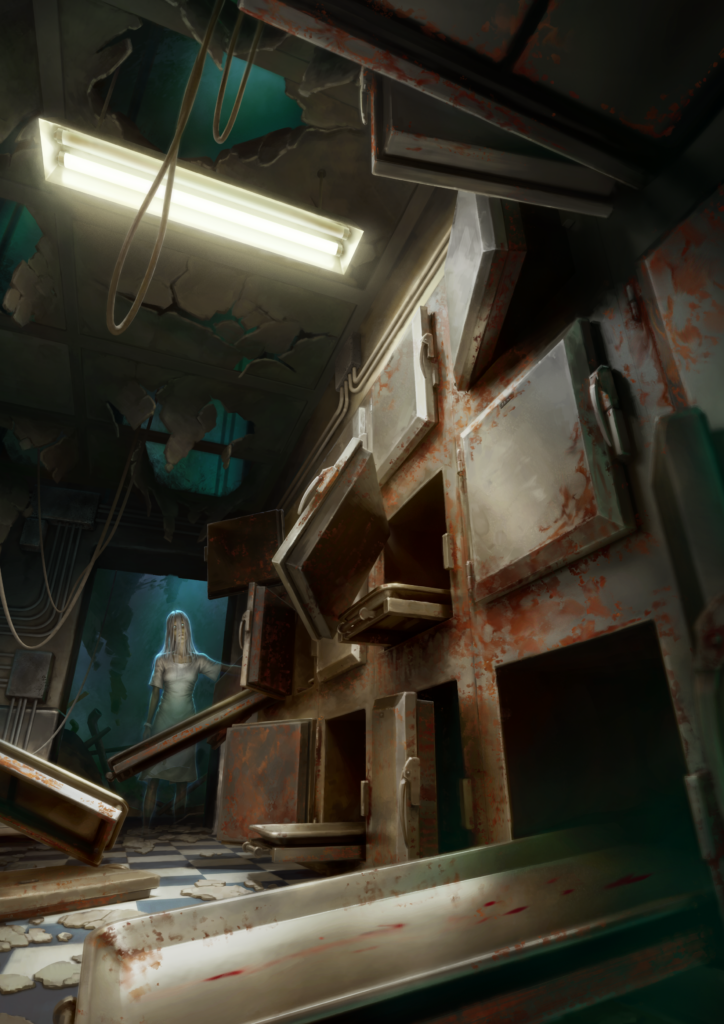
We return to those oddities in the world of Curseborne: liminalities. Many of your Curseborne stories will be set in and around liminal spaces, because they’re where weird things concentrate. Perhaps there’s been a spate of disappearances and they all centre on one sewer entrance. Maybe there’s been an uptick in violence, and everyone charged with assault has visited the same church. It could be that a liminal space is making these things happen, or it might be that a creature has made this liminality their lair, and from within it they’re corrupting the world beyond.
What Lives in a Liminal Space?
As you’ll find through reading the various blogs we’ve been posting, Curseborne is a game where adversaries are plentiful, and many of them go beyond uncanny into the alien and otherworldly. Some of these adversaries emerge from realms known as Battlegrounds – outside spaces, where the laws of physics and human perception extend, twist, or break beyond mortal reckoning. Others come from farther, stranger spaces still. Such creatures come to occupy liminal spaces for any of the following reasons:
- Liminal spaces make for excellent hunting hides.
- Liminal spaces act as sanctuaries between our world and many others.
- Liminal spaces are wonderful spots to lure idiots into.
- Liminal spaces can be molded, if the right kind of creature inhabits them.
- Liminal spaces tend to avoid scrutiny unless they desire it.
As a result, all manner of fiends occupy these spaces. Some of them are malevolent, some of them are just strange, and some are hiding and prepared to make deals to secure their safety. It’s that latter kind of being that might appear as a helpful, or at least curious Storyguide character in your Curseborne stories, as not everything from the outside need be trying to eat your face.
Though of course, some things will smile at you, make a deal, and then eat your face.
Common Grounds
The Accursed can often sense a liminality, and providing it isn’t outwardly hostile to them, may engineer such spaces as neutral grounds and safe spaces for their crews and other members of their families or Lineages. They’re not common enough to appear on every street corner, but it’s typical that a preponderance of Accursed of a similar Lineage occupying a space might make it liminal and therefore better suited to their purposes. In this way, a locale’s water supply may start spouting fountains of blood, a library may slowly reveal hidden archives of forbidden tomes, or a city park might suddenly attract wild animals or the terrain become more rough and foreboding for non-Primal, as an example, as the world shifts around the Accursed to accommodate them.
Lineages place a high value on territory in a city, in part because these changes take time and giving a secure location up to other Accursed (or worse creatures) represents a hefty sacrifice of time and energy. Wars have been started for less, and it’s when the patriarch of the city’s Hungry calls his kin to his side that a crew’s loyalties are truly tested. At that time, does the Hungry Gaki turn on her Primal Lykan, Sorcerous Reeve, and Dead Warden friends just because daddy commands it? Or does she work to undermine him, or stop this conflict before it boils over? Or, maybe, does the crew make itself useful to the city’s Hungry and therefore secure allies and sponsors for the future?
When not fought over, liminal spaces are ideal grounds for deals, information exchanges, and diplomatic actions. They can be taken in these between spaces without fear of mortal scrutiny, though with their being liminalities, it’s always possible something from the other side is watching and waiting to drag every participant to their realm, or simply use the intelligence of what’s taken place there as a bargaining chip in future.

Example: Gilt Street Shopping Mall
Construction on the Gilt Street Shopping Mall began in 1991. It didn’t conclude until 2014. So wracked was it by curses, from machinery failures and on-site accidents, investments bottoming out and thefts of building materials, to stranger incidents besides, nobody in the city truly expected Gilt Street to open. But now the doors are open and the much-anticipated foot traffic… Is nowhere to be seen. Anyone set on shopping in meatspace heads to the downtown high street and everyone else shops online.
Rapidly, the independent retailers closed. The franchises only stuck around for as long as it was cost-effective to run down their contracts. Now, only three businesses occupy the Gilt Street Shopping Mall: a Subway, a bulk goods outlet named Take It or Leave It, and a video rental store named Zap.
Zap is the oddity in this equation given its outdated media, and yet the owner — a giant of a man named Lin Deng — keeps the lights on and the popcorn machine stocked. There are all kinds of rumors surrounding what takes place in the store’s adult section, behind the beaded curtain, but Deng isn’t a friendly, chat-your-ear-off kind of salesman. You tell him what you’re looking for and if he has it, he’ll tell you where it is. Supposedly, he has VHS copies of movies that never saw mainstream release or were cancelled in production, such as Batgirl and The Many Faces of Jesus. He even has a poster for The Day the Clown Cried behind the counter, but he won’t comment on it.
The mall is a haven after hours, because when the retailers go home (Subway closes just before midnight, dumping a day’s worth of uneaten food out back) the security guard Del Barr is supposed to lock up. Unfortunately, he’s been dead for a month, and nobody noticed. Teens from the inner city and outskirts use the mall as a playful warzone. Piece by piece, they’re destroying it from within. They all say the reflections of workers past walk this place from 3am, which is their signal to leave. If one of the reflections touches you, you end up trapped in the mall’s glass façade with them.

